Best Medical Alert Systems with Fall Detection: The Ultimate Guide IN 2024
Medical alert systems are devices designed to provide emergency assistance to users, especially older adults, in case of medical emergencies, falls, or other situations where immediate help is needed.
Best mobile fall detection
Best For Pricing Options
Best For Flexibility
Best For At-Home Systems
Brio House is an independent review site. We may earn money when you click links inside our site.
Medical alert systems are devices designed to provide emergency assistance to users, especially older adults, in case of medical emergencies, falls, or other situations where immediate help is needed. These systems typically consist of a wearable device, such as a pendant or wristband, and a base station that connects to a monitoring center. When the user presses the button on the wearable device, the system sends a signal to the monitoring center, which then contacts emergency services or designated contacts.
The Importance of Fall Detection in Medical Alert Systems
Fall detection is a crucial feature in most medical alert systems now. It uses advanced sensors to automatically detect falls, even when the user is unable to press the emergency button. This feature is particularly important for older adults who live alone or are at a high risk of falling. According to the Centers for Disease Control and Prevention, more than one-fourth of Americans who are 65 and older experience a fall each year. Therefore, having a medical alert system with automatic fall detection can provide extra security and peace of mind.

Overview of the Best Medical Alert Systems with Fall Detection
Based on the latest research and testing, some of the best medical alert systems with automatic fall detection, include Medical Guardian, Bay Alarm Medical, and Lifeline Medical Alert Systems. They offer a range of features, such as long battery life, wide device range, and various connection types. They also offer automatic fall detection as an optional feature, which can be added for an additional monthly fee.
Medical alert companies: Guardian stands out for its industry-leading device range and fast response times. Bay Alarm Medical is known for its long battery life and high customer reviews. Lifeline Medical Alert Systems developed AutoAlert fall detection technology, which combines three fall detection technologies for high accuracy.
It’s important to note that the effectiveness of a fall detection system can vary, and no system can detect 100% of falls. Therefore, users should consider their individual needs and circumstances when choosing the right medical alert or fall detection system.

What are fall detection pendants?
Fall detection pendants are wearable devices that can automatically detect if the wearer has taken a fall.
What are the Best Medical Alert Systems with Fall Detection in 2024?
- Medical Guardian: Best mobile fall detection
- Bay Alarm Medical: Best for pricing options
- Lifeline Medical Alert Systems: Best for flexibility
- MobileHelp: Best for at-home systems
- Aloe Care Health: Best for impaired mobility
- ADT: Best for customer-friendly practices
- GetSafe: Best for hands-free systems
- Medical Alert: Best for extended coverage

Detailed Reviews of Top Medical Alert Systems with Fall Detection in 2024
1. Medical Guardian
Best mobile fall detection
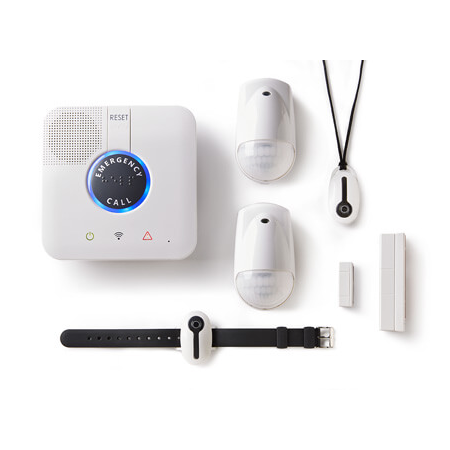
Medical Guardian
Our Rating:

5.0
It offers a 1,300-foot range for the at-home landline system and 1,400-foot protection range for the at-home cellular system. It has a lightweight mobile device and smartwatch option. The response time during the system test was less than 15 seconds.
However, it has a limited one-year warranty and locks you into a contract that is month-to-month after a three-month minimum commitment.
The fall detection feature costs an additional $10/month. The system is designed to detect falls automatically and send an alert to the monitoring center. This feature is available on their mobile devices and smartwatches.
2. Bay Alarm Medical
Best for pricing options
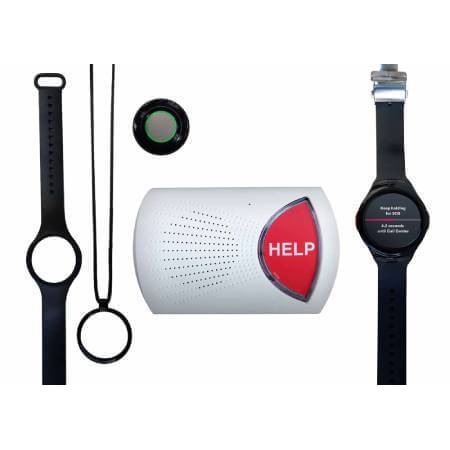
Bay Alarm Medical
Our Rating:

4.7
It offers a 1,000-foot signal range for the in-home system and a lightweight device for active and mobile adults. It provides free GPS monitoring services with mobile and smartwatch subscriptions. However, the landline and cellular at-home systems have the same protection range from the base station (1,000 feet), and the warranty only covers the base station.
Users can add fall detection feature as an add-on service for an additional monthly fee. It is available with the in-home system by wearing a fall detection pendant or with the SOS Mobile which has built-in fall detection capability.
If sudden downward motion is followed by a lack of movement, the detection system is triggered to automatically initiate a fall response.
3. Lifeline Medical Alert Systems
Best for flexibility

Lifeline Medical Alert Systems
Our Rating:

4.6
It offers both in-home and mobile options. The in-home system comes with a base station and a wearable help button, which can be worn as a pendant or a wristband. The system has a range of up to 800 feet from the base station.
The mobile system is a small, lightweight device that includes GPS technology. It comes with a charging cradle and can be worn as a pendant. Lifeline does not require long-term contracts, and it offers a 30-day money-back guarantee, providing flexibility and peace of mind for users.
Lifeline also offers an optional fall detection pendant, which can automatically detect falls and call for help.
4. MobileHelp
Best for at-home systems

MobileHelp
Our Rating:

4.7
It offers a 1,400-foot protection range with the at-home cellular system and provides three at-home options and more advanced at-home devices like the digital tablet Touch Classic.
However, there is a $49.95–$99.95 processing fee charged for some devices, and the monitoring center is not TMA Five Diamond Certified.
Fall detection is available as an add-on feature. The system is designed to detect falls and automatically send an alert to the monitoring center. This feature is compatible with the Classic, Solo, and Duo systems.
5. Aloe Care Health
Best for impaired mobility
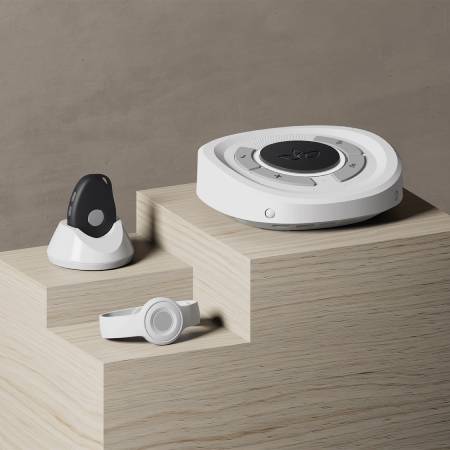
Aloe Care Health
Our Rating:

4.6
The base station (the Hub) has built-in motion, home temperature, and air quality sensors. The Aloe Care app is included with all subscriptions.
However, it only has a 200-foot range from the base station, and you must say “Emergency” several times to get an emergency response from the Smart Hub or fall detection sensor.
The Mobile Companion Go device has built-in fall detection technology. The Essentials Plus and Total Care packages also include in-home fall detection with the Smart Fall Sensor.
6. ADT
Best for customer-friendly practices

ADT
Our Rating:

4.6
It offers free next-day shipping, no equipment or activation fees, a 24/7 sales team, and frequent discounts on fall detection or monthly monitoring service fees. However, fall detection is not available for the in-home landline system (Medical Alert Basic).
Fall detection is available for an additional $10 per month for the Medical Alert Plus and On-The-Go systems, but it’s not compatible with the Medical Alert Basic. You must wear the fall detection lanyard for fall detection to work.
7. GetSafe
Best for hands-free systems
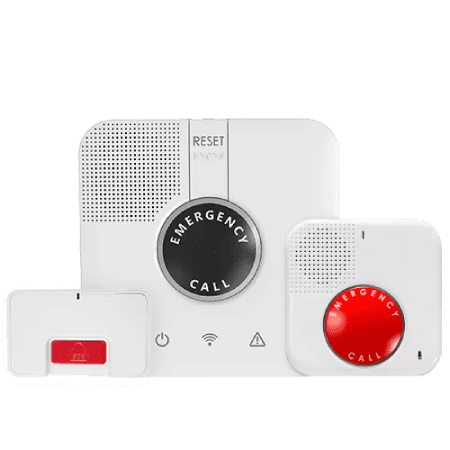
GetSafe
Our Rating:

4.6
It offers voice-activated emergency response and three available packages designed to fit different home sizes. However, add-ons can get expensive ($5–$79 per month), and there are expensive equipment fees ($79–$279).
Fall detection is available as an add-on feature. The system is designed to detect falls and automatically send an alert to the monitoring center. You must use the wearable button for automatic fall detection.
8. Medical Alert
Best for extended coverage
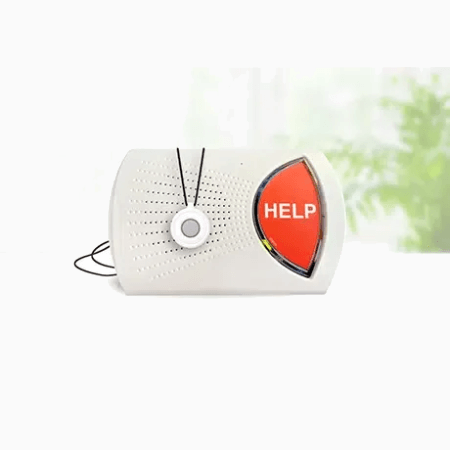
Medical Alert
Our Rating:

4.6
The at-home system works in the U.S., Puerto Rico, Canada, and the Virgin Islands. It offers a free app included with all subscriptions. However, the monitoring center isn’t TMA Diamond Certified, and the warranty is not included (device protection plan costs extra).
The fall detection feature is an optional add-on with the purchase of every Medical Alert system. The system is designed to detect falls and automatically send an alert to the monitoring center.
Mobile Medical Alert Device Reviews
Mobile medical alert devices are becoming increasingly popular as they allow users to maintain their independence while still having access to emergency help if needed.
- Most mobile medical alert devices come with a variety of features, including fall detection, GPS tracking, and two-way communication.
- Fall detection is a crucial feature for many users. This feature can detect if the user has fallen and automatically contact the emergency services.
- Mobile medical alert devices often include GPS tracking, which can be crucial in an emergency situation. This feature allows the emergency responders to locate the user quickly and accurately.
- Two-way communication is another common feature of mobile medical alert devices. This allows the user to speak directly with the emergency monitoring center, providing them with important information about their situation.
- Many mobile medical alert devices are also water-resistant, allowing users to wear them in the shower or in the rain.
- The battery life of mobile medical alert devices can vary, but many devices offer a long battery life to ensure that users are always protected.
Comparison of Other Medical Alert Systems
There are many medical alert system companies offering a variety of devices and services. Here are some key points to consider when comparing other medical alert systems:
- Fall detection: This is a crucial feature for many medical alert system users. Fall detection devices can detect if the user has fallen and automatically contact the emergency services. However, it’s important to note that not all medical alert systems offer fall detection, and those that do may charge an additional monthly fee for this service.
- Monitoring center: The monitoring center is the hub that receives alerts from the medical alert device and dispatches emergency services if needed. It’s important to consider the quality and reliability of the monitoring center when choosing a medical alert system.
- Battery life: The battery life of the medical alert device can be a crucial factor, especially for mobile medical alert system users. A device with a long battery life ensures that users are always protected.
- Activation fees: Some medical alert system providers charge an activation fee when you first sign up for their service. It’s important to factor this into the overall cost of the system.
- Monthly monitoring fee: This is the ongoing cost of using the medical alert system. The monthly monitoring fee can vary widely between different medical alert system providers, so it’s important to compare these costs.
- Cellular connection: Some medical alert systems use a cellular connection to communicate with the monitoring center. This can be a beneficial feature for users who don’t have a landline or who want to use their device on the go.
- Water resistance: Many medical alert devices are water-resistant, allowing users to wear them in the shower or in the rain. This is an important feature as many falls happen in the bathroom.
- Two-way communication: This feature allows the user to speak directly with the monitoring center in an emergency situation. This can be crucial for providing important information about the user’s situation and location.
- False alarms: Some medical alert systems have a higher rate of false alarms than others. This can be a nuisance for users and can potentially lead to unnecessary emergency callouts. It’s important to consider the reliability of the fall detection technology when choosing a system.
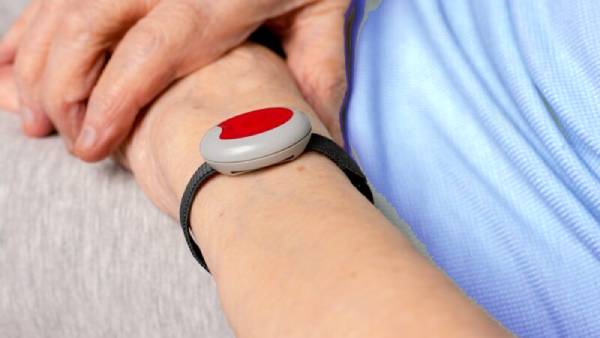
Features of Medical Alert Systems with Fall Detection
Automatic Fall Detection
Automatic fall detection is a crucial feature in many medical alert systems. This technology is designed to detect if the user has taken a fall and automatically send an alert to the monitoring center. This feature is particularly beneficial for individuals who may become unconscious or incapacitated after a fall and unable to manually activate their alert system. However, it’s important to note that while this technology has improved significantly, it may not detect 100% of falls and may occasionally trigger false alarms.
Mobile Systems and On-the-Go Systems
Mobile systems and on-the-go systems are designed to provide protection both at home and when the user is out and about. These systems typically operate over cellular networks and incorporate GPS technology. This means that if a user gets lost or presses the call button for help but is unable to talk, the monitoring service can locate them. This feature is particularly useful for active older adults who often leave their homes.
Battery Life and Water Resistance
The battery life of a medical alert device is a crucial factor to consider. Some devices have batteries that last several years, while others may need to be charged every few days. It’s also important to consider whether the device is water resistant. Many falls happen in the bathroom, so having a water-resistant device can provide added peace of mind.
Two-Way Communication and Base Station
Two-way communication allows the user to speak directly with the emergency responders at the monitoring center through the medical alert device. This feature is typically available through a base station located in the user’s home, or through a mobile device. This allows the user to explain their situation and receive immediate assistance.
Location Tracking and Fall Detection Technology
Location tracking and automatic fall detection technology are key features in many medical alert systems. Location tracking, often through GPS, allows the monitoring center to locate the user in case of an emergency. Fall detection technology, on the other hand, can automatically detect if the user has taken a fall and send an alert to the monitoring center. This can be particularly beneficial for users who may become unconscious or incapacitated after a fall.
Costs and Contracts of Medical Alert Systems
Understanding Monthly Fees and Activation Fees
- Monthly fees for medical alert systems can vary greatly depending on the features and services provided. Basic in-home systems can start from around $25 per month, while more advanced systems with mobile capabilities can cost up to $45 or more per month. Some providers may also charge an initial activation fee to set up the system. It’s important to understand what these fees cover, such as 24/7 monitoring, access to emergency services, and maintenance of the system.
The Cost of Adding Fall Detection
- Fall detection is a crucial feature for many medical alert system users, especially older adults who are at a higher risk of falls. However, this feature often comes at an additional cost. The fall detection cost can vary among providers, but it typically ranges from $10 to $15 extra per month. This feature uses advanced sensors to detect falls automatically and alert the monitoring center, even if the user can’t press the help button.
Long-Term Contracts and Price Lock Guarantee
- Some medical alert companies may offer discounts for users who commit to long-term contracts, such as annual or quarterly plans. However, it’s essential to read the terms carefully to understand the cancellation policy and whether the rate is fixed or can increase over time. Some companies offer a price lock guarantee, ensuring that the monthly rate won’t increase for the duration of the contract.
Fall Detection Typically Costs and Cost Comparison
- As mentioned, fall detection typically costs an additional $10 to $15 per month. However, considering the potential medical costs associated with untreated falls, many users find this feature to be a worthwhile investment. When comparing costs among different medical alert system providers, consider not only the monthly fees but also the value and quality of the services provided. For instance, some systems may offer advanced features like GPS tracking, two-way communication, and medication reminders, which can provide added value and peace of mind.
Remember, the right medical alert system for you or your loved one should offer a balance of cost, features, and reliable service. Always do your research and ask questions to ensure you’re making an informed decision.
Choosing the Right Medical Alert Provider
Assessing the Needs of Medical Alert System Users
- The first step in choosing the right medical alert system is to assess the needs of the user. Consider their lifestyle, health conditions, and living situation. For instance, an active older adult who often leaves the house may benefit from a mobile medical alert device with GPS tracking. On the other hand, someone who spends most of their time at home may find a basic in-home system sufficient.
Considering the Disease Control and Medication Reminders
- Some medical alert systems offer features that can be particularly helpful for users with chronic diseases. For example, medication reminders can help ensure that important medications are taken on schedule. Additionally, some systems can monitor vital signs and alert users or caregivers to potential health issues. These features can be a significant factor in managing disease control.
Evaluating the Mobile Device and Cellular Connection
- If the user is often out and about, a mobile medical alert system can provide protection wherever they go. These systems operate over a cellular connection and often include GPS tracking, allowing the monitoring center to locate the user in case of an emergency. When evaluating these systems, consider the device’s battery life, the reliability of the cellular network it uses, and whether it offers features like fall detection.
Understanding the Role of the Monitoring Center and Emergency Responders
- The monitoring center is a critical component of any medical alert system. When the user presses the help button, the call is sent to the monitoring center, where trained operators can assess the situation and dispatch emergency responders if necessary. It’s important to choose a system with a reliable, 24/7 monitoring center. Some systems also offer the option to contact family members or caregivers directly.
Tips for Family Members and Caregivers
- If you’re a family member or caregiver choosing a system for a loved one, involve them in the decision-making process. Understand their needs and preferences, and consider which features they would find most useful and comfortable to use. Remember, the best medical alert system is one that the user feels comfortable with and will use consistently. Also, be sure to check the return policy in case the system doesn’t meet your expectations.

Common Concerns and Solutions
Dealing with False Alarms
False alarm can be a common issue with medical alert systems, especially those equipped with fall detection. While the technology has improved significantly, it’s not perfect. Sometimes, the fall detection feature might send a signal when any type of fast movement is detected. Other times, when a real fall occurs, it might not sense it as a true fall, and therefore won’t alert the monitoring center. However, it’s generally agreed that having an imperfect fall detection device is still better than having no fall detection at all.
Understanding How Fall Detection Works
Fall detection is a feature that utilizes advanced algorithms, gyroscopes, and accelerometers to detect sudden slips or falls. When a fall is detected, the fall detection device signals the monitoring center immediately. This technology helps to alleviate the fear of a potentially devastating slip or fall. Since many falls happen in the shower, fall detection devices are usually 100 percent water-resistant and meant to be taken into high-risk fall zones like the bathroom.
The Reliability of Fall Detection Devices
While fall detection devices are not 100% accurate, they are still considered a valuable feature in medical alert systems. The technology in mobile fall detection alone is constantly being refined and improved, and even with its current limitations, it can still be a lifesaver in emergency situations. It’s important to remember that fall detection is just one aspect of preventing falls and serious injuries.
The Role of the Emergency Monitoring Center
The emergency monitoring center plays a crucial role in medical alert systems. When the help button is pressed, the signal is sent to the monitoring center, where professional, friendly agents are ready to process the emergency alert as fast and accurately as possible. They follow the protocol to decide the best course of action, which might mean contacting a caretaker or family member, or dispatching police, fire, or EMS for more serious emergencies.
Addressing Concerns about Privacy and Independence
Medical alert systems are designed to provide safety and peace of mind for older adults without compromising their privacy and independence. The devices are discreet and easy to use, and the services are designed to be non-intrusive. The goal of medical alerts is to provide a safety net that allows older adults to live independently with confidence, knowing that help is just a button press away if needed.
The Future of Medical Alert Systems
Advances in Fall Detection Technology
Fall detection technology has come a long way since its inception. The initial systems that built in fall detection were primarily based on accelerometers, which detected sudden changes in motion. However, these systems were prone to false alarms, as they could not distinguish between a genuine fall and other rapid movements.
Today, the technology has evolved significantly, incorporating more sophisticated sensors and algorithms to improve accuracy. For example, some systems now use gyroscopes in addition to accelerometers, allowing them to detect changes in orientation as well as motion. This can help to distinguish between a fall and activities like sitting down quickly or jumping.
Moreover, advancements in machine learning have enabled the development of algorithms that can learn from past data to predict future falls. These algorithms can analyze a wide range of data, including changes in gait, balance, and strength, to identify individuals who are at high risk of falling. This predictive capability is a significant step forward in fall detection technology, as it allows for proactive measures to prevent falls rather than just reactive measures to respond to them.
The Impact of AI and Machine Learning on Fall Detection
Artificial intelligence (AI) and machine learning are playing an increasingly important role in the development of medical alert systems with fall detection. These technologies can analyze large amounts of data to identify patterns and make predictions, which can greatly enhance the effectiveness of fall detection systems.
For example, machine learning algorithms can be trained to recognize the unique patterns of movement associated with different types of falls. This can help to offer fall detection and reduce the number of false alarms, as the system can distinguish between a genuine fall and other types of rapid movement.
AI can also be used to predict the likelihood of a fall based on a variety of factors, including the individual’s health status, physical activity levels, and environmental conditions. This predictive capability can enable proactive measures to prevent falls, such as alerting the individual or their caregiver to potential hazards or suggesting modifications to the individual’s behavior or environment.
The Role of Wearable Technology in Medical Alert Systems
Wearable technology is another area that is having a significant impact on the development of medical alert systems. Devices such as smartwatches and fitness trackers can continuously monitor an individual’s physical activity and health status, providing valuable data for fall detection and prevention.
For example, these devices can monitor the individual’s heart rate, sleep patterns, and physical activity levels, which can provide insights into their overall health and fitness. They can also detect changes in the individual’s movement patterns that may indicate an increased risk of falling.
Moreover, wearable devices can provide a convenient and unobtrusive means of alerting the individual or their caregiver in the event of a fall. Some devices can even automatically detect a fall and send an alert without the individual needing to press a button.
Predictions for the Future of Medical Alert Systems
As technology continues to advance, we can expect to see even more improvements in medical alert systems. For instance, we might see the integration of virtual reality (VR) and augmented reality (AR) technologies, which could provide immersive training environments to help individuals improve their balance and coordination, thereby reducing their risk of falling.
We might also see the development of more sophisticated AI algorithms that can analyze a wider range of data to predict falls with even greater accuracy. These algorithms could incorporate data from a variety of sources, including wearable devices, smart home sensors, and electronic health records.
Furthermore, as the Internet of Things (IoT) continues to expand, we might see greater integration between medical alert systems and other connected devices. This could enable more comprehensive monitoring of individuals’ health and activity levels, and more coordinated responses to emergencies.
The Importance of Continuous Innovation in the Industry
Continuous innovation is crucial in the medical alert systems industry. As the population ages and the prevalence of chronic diseases increases, the demand for effective and reliable medical alert systems is likely to grow. To meet this demand, companies in the industry must continually innovate and improve their products.
One area where innovation is particularly important is in the development of algorithms for fall detection and prediction. As we’ve seen, machine learning and AI can play a crucial role in this regard, but there is still much room for improvement. For example, future algorithms could incorporate more diverse data sources, such as electronic health records and social media posts, to make more accurate predictions.
Another area where innovation is needed is in the design of wearable devices. While current devices are already quite sophisticated, they could be made even more effective and user-friendly. For example, future devices could be more customizable, allowing users to choose the types of alerts they receive and the people who are notified in the event of a fall. They could also incorporate more advanced sensors, such as skin temperature and sweat sensors, to provide more comprehensive health monitoring.
Finally, innovation is needed in the way medical alert systems interact with other devices and systems. With the rise of the Internet of Things, there are increasing opportunities for medical alert systems to integrate with other smart devices, such as home security systems and personal digital assistants. This could enable more coordinated and efficient responses to emergencies, as well as more proactive measures to prevent falls and other health issues.
The future of medical alert systems is bright, but it will require continuous innovation and improvement to realize its full potential. As technology continues to advance, we can look forward to medical alert systems that are more accurate, more user-friendly, and more integrated with our daily lives.
Frequently Asked Questions:
What is a medical alert system?
A medical alert system is a device that allows users, typically older adults or people with serious health issues, to call for help in an emergency. The user can press a button on their device to send an alert to a monitoring center, where trained operators can assess the situation and dispatch emergency responders if necessary.
Are medical alert systems expensive?
The cost of a medical alert system can vary widely depending on the features it offers. Basic in-home systems can be relatively affordable, while more advanced systems with features like fall detection, GPS tracking, and mobile connectivity can be more expensive. There may also be additional costs for monitoring services.
Can medical alert systems be used outside the home?
Yes, many medical alert systems offer mobile systems that can be used on the go. These systems use a cellular connection to communicate with the monitoring center, and many include GPS tracking so the user’s location can be determined in an emergency.
What happens if I press the help button by accident?
If you press the help button by accident, you can simply tell the operator at the monitoring center that it was a false alarm. They will cancel the alert and no emergency responders will be dispatched.
What are fall detection pendants?
Fall detection pendants are wearable devices that can automatically detect if the wearer has taken a fall. They use sensors and algorithms to monitor the wearer’s movements and identify patterns that indicate a fall. If a fall is detected, the pendant can automatically send an alert to a monitoring center or a designated contact.
What is an on-the-go system?
An on-the-go system is a type of medical alert system that is designed to be used outside the home. These systems typically use a cellular connection to communicate with the monitoring center, and many include GPS technology so the user’s location can be determined in an emergency. They are ideal for active older adults who want the security of a medical alert system while they are out and about.
How does automatic fall detection work?
Automatic fall detection works in a similar way to regular fall detection, but it has the added feature of being able to send an alert without the user having to press a button. This can be particularly useful if the user is unconscious or otherwise unable to press the help button after a fall.
What is a caregiver app?
A caregiver app is a mobile application that allows caregivers to monitor the user’s medical alert system. The app can provide real-time updates on the user’s status, send alerts if the system detects a fall or other emergency, and provide other useful features to help caregivers provide the best possible care.
Conclusion: The Importance of Choosing the Best Medical Alert System with Fall Detection
Choosing the best medical alert system with optional fall detection is a crucial decision that can significantly impact the safety and well-being of the user. These systems can provide a lifeline in an emergency, allowing the user to call for help at the press of a button. The fall detection feature can be particularly valuable, as it can automatically send an alert if the user takes a fall and is unable to press the button themselves.
However, not all medical alert systems are created equal. It’s important to consider factors like the reliability of the fall detection feature, the quality of the medical alerts and monitoring center, and the cost of the system and monitoring services. By taking the time to research and compare different systems, you can find the one that best meets your needs and provides the highest level of protection.
In the end, the best medical alert system is one that the user feels comfortable with and will use consistently. With the right system in place, users can maintain their independence and continue to live their lives with confidence on the go anywhere, knowing that help is just a button press away if they need it.
